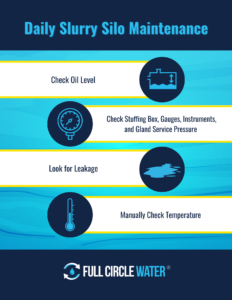
Slurry silo filtration systems are built to withstand substantial wear, but even the strongest pumps will still need regular maintenance. When a slurry pump malfunctions due to poor maintenance, a lot of things can go wrong. To keep your operation running smoothly and to prevent potential injury, pump breakdowns, and extended downtime, keep up on preventative maintenance.
Daily Maintenance for Efficient Wastewater Decanting
It’s good practice to examine key elements of your slurry pump daily. You don’t need to examine every aspect of the pump every day, but there are several components to a slurry pump that should be checked at least once a day.

Oil
An important part of slurry pump maintenance is checking the oil. As always, be sure your pump is off before examining or performing maintenance on heavy equipment. Even if you have a well-functioning sealing device, water can still find its way into the oil. If your oil is diluted with too much water, your pump might not function at peak efficiency. Diluted oil can be easily spotted because of its milky appearance.
Temperature
Slurry pumps with built-in temperature sensors will often disable those sensors when the motor gets too hot. Checking your pump’s temperature manually ensures you always have access to reliable temperature information—even when your temperature sensors are off. Most pump bearings should be between 140 and 170 degrees Fahrenheit but shouldn’t exceed 200 degrees. If your pump’s temperature is getting high, it may be experiencing excess lubrication.
Other important elements of your slurry pump system should be checked daily, including the stuffing box, gauges and instruments, and gland service pressure. You should also check for signs of leakage, especially at the pump casing’s weep holes.
Weekly Industrial Slurry Silo Maintenance
The wetted parts of the pump are more likely to experience excessive wear, especially the impeller. On a weekly basis, check these parts for signs of major wear and tear. In addition, ensure your impeller has adequate clearance, which can be found in your pump’s manual.
Lastly, record the gauge readings and compare them to the week prior to determine if there are any major changes, as this could point to a more serious issue.
Quarterly Maintenance for Your Slurry Silo Plant
If your slurry pump has a belt, it should be checked at least once a quarter. Look for signs of excess wear, and using a tension tester or gauge, check for proper tension. Belts that are too tight can damage the motor bearings, and belts that are too loose can impact the pump’s performance, creating slippage. As you’re checking its belt, you should also change your pump’s oil.
Each quarter, your slurry pump should be inspected for serious wear to determine if service or replacement is needed. While you examine the pump, take the opportunity to clean and oil the studs and threads to keep them working smoothly.
Keep Your Slurry Silo Filtration Systems Highly Functional
Whether you or your team is performing your slurry pump maintenance, keep a detailed record of what was serviced, what parts require replacement, and any troubling finds. Use a checklist and calendar to organize your maintenance schedule and ensure essential tasks are performed on time.
If, along the way, you notice any leakage, major misalignments, excessive temperatures, or extreme wear—get in touch with Full Circle Water for help with all your slurry pump maintenance needs. Our amazing service professionals are ready to travel to your business and get your pump back in working order.